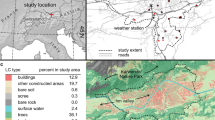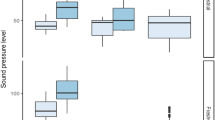Abstract
Context
It is widely accepted that wildlife is subjected to detrimental human noise within urban landscapes but little is known about how the intensity of land use changes soundscapes.
Objectives
The objective of this research was to produce quantitative associations between characteristics of ambient soundscapes and land use intensity. These relations were used to examine the 2 kHz demarcation between anthrophony and biophony and compare the impact of different sized contributing areas on ambient soundscape characteristics.
Methods
This study related the surrounding land use intensity of 67 sites in north central Florida (USA) to several metrics describing their recorded soundscapes. Land use intensity was measured remotely at three scales using the landscape development intensity index (LDI).
Results
The analysis revealed that the LDI index had a statistically significant effect on soundscape characteristics after controlling for important factors such as climate, season, and attenuation due to hard ground. The trends between LDI and soundscape confirmed that human generated sounds are loud, continuous, and occupy low frequencies. The evenness of the sound distribution decreased with landscape intensity and LDI correlated significantly with sound below 3 kHz. Land use intensity within a 100 and 500-m radius contributing area were most closely related to soundscape metrics.
Conclusions
LDI is a tool with the potential to predict the extent and intensity of anthropogenic noise disturbance on wildlife from remote sensing data. The utility of this tool allows for widespread application to identify and mitigate conflicts in the acoustic realm between human noise and wildlife.


Similar content being viewed by others
References
Barber JR, Crooks KR, Fristrup KM (2010) The costs of chronic noise exposure for terrestrial organisms. Trends Ecol Evol 25(3):180–189
Bayne EM, Habib L, Boutin S (2008) Impacts of chronic anthropogenic noise from energy-sector activity on abundance of songbirds in the boreal forest. Conserv Biol 22(5):1186–1193
Bee M, Swanson EM (2007) Auditory masking of anuran advertisement calls by road traffic noise. Anim Behav 74(6):1765–1776
Bioacoustics Research Program (2011) Raven Pro: Interactive Sound Analysis Software (Version 14) [Computer software]. The Cornell Lab of Ornithology, Ithica
Bouchard M (2009) Wetland resources of Eastern South Dakota; drainage patterns, assessment techniques, and predicting future risks. South Dakota State University, South Dakota
Brown MT, Vivas MB (2005) Landscape development intensity index. Environ Monit Assess 101(1–3):289–309
Brumm H, Slabbekoorn H (2005) Acoustic communication in noise. Adv Stud Behav 35:151–209
Brunni A, Daniel JM, Foote JR (2014) Dawn chorus start time variation in a temperate bird community: relationships with seasonality, weather, and ambient light. J Ornithol 155(4):877–890
Can A, Leclercq L, Lelong J, Botteldooren D (2010) Traffic noise spectrum analysis: dynamic modeling vs experimental observations. Appl Acoust 71(8):764–770
Charif RA, Waack AM, Strickman LM (2010) Raven pro 1.4 user’s manual. The Cornell Lab of Ornithology, Ithica
Chen TS, Lin HJ (2011) Application of a landscape development intensity index for assessing wetlands in Taiwan. Wetlands 31(4):745–756
Depraetere M, Pavoine S, Jiguet F, Gasc A, Duvail S, Sueur J (2012) Monitoring animal diversity using acoustic indices: implementation in a temperate woodland. Ecol Ind 13(1):46–54
Dooling RJ, Popper A (2007) The effects of highway noise on birds. Environmental BioAcoustics LLC, Rockville
ESRI (2014) ArcGIS desktop: release 10.3. Environmental Systems Research Institute, Redlands
Farina A, Pieretti N (2014) Sonic environment and vegetation structure: a methodological approach for a soundscape analysis of a Mediterranean maqui. Ecol Inform 21:120–132
FGDL Metadata Explorer (2015) University of Florida GeoPlan Center, Gainesville
Fonseca PJ, Revez MA (2002) Temperature dependence of cicada songs (Homoptera, Cicadoidea). J Comp Physiol 187:971–976
Fore LS (2004) Development and testing of biomonitoring tools for macroinvertebrates in Florida streams. Statistical Design, Seattle, Washington. A report for the Florida Department of Environmental Protection, Tallahassee, p 62
Fore LS (2005) Assessing the biological condition of Florida lakes: development of the lake vegetation index (LDV). Statistical Design, Seattle, Washington. A report for the Florida Department of Environmental Protection, Tallahassee, p 29 & Appendixes
Forman RTT, Sperling D, Bissonette JA, Clevenger AP, Cutshall CD, Dale VH, Fahrig L, France R, Goldman CR, Heanue K, Jones JA, Swanson FJ, Turrentine T, Winter TC (2003) Road ecology: science and solutions. Island Press, Washington
Fuller S, Axel AC, Tucker D, Gage SH (2015) Connecting soundscape to landscape: which acoustic index best describes landscape configuration? Ecol Ind 58:207–215
Gage SH, Axel AC (2014) Visualization of temporal change in soundscape power of a Michigan lake habitat over a 4-year period. Ecol Inform 21:100–109
Habib L, Bayne EM, Boutin S (2007) Chronic industrial noise affects pairing success and age structure of ovenbirds Seiurus aurocapilla. J Appl Ecol 44(1):176–184
ISO (1993) Acoustics—Attenuation of sound during propagation outdoors—part 1: calculation of the absorption of sound by the atmosphere (Standard No. 9613-1). International Organization for Standardization, Geneva
ISO (1996) Acoustics—Attenuation of sound during propagation outdoors—part 2: general method of calculation (Standard No. 9613-2). International Organization for Standardization, Geneva
Joo W (2009) Environmental acoustics as an ecological variable to understand the dynamics of ecosystems. Dissertation. Michigan State University
Joo W, Gage SH, Kasten EP (2011) Analysis and interpretation of variability in soundscapes along an urban–rural gradient. Landsc Urban Plan 103(3–4):259–276
Kasten EP, Gage SH, Fox J, Joo W (2012) The remote environmental assessment laboratory’s acoustic library: an archive for studying soundscape ecology. Ecol Inform 12:50–67
Kociolek AV, Clevenger AP, St Clair CC, Proppe DS (2011) Effects of road networks on bird populations. Conserv Biol 25(2):241–249
Krause BL, Gage SH, Joo W (2011) Measuring and interpreting the temporal variability in the soundscape at four places in Sequoia National Park. Landsc Ecol 26(9):1247–1256
Laiolo P (2010) The emerging significance of bioacoustics in animal species conservation. Biol Conserv 143(7):1635–1645
Lane CR, Brown MT (2007) Diatoms as indicators of wetland condition. Ecol Ind 7:521–540
Mack JJ (2006) Landscape as a predictor of wetland condition: an evaluation of the Landscape Development Index (LDI) with a large reference wetland dataset from Ohio. Environ Monit Assess 120:221–241
Makarewicz R, Sato Y (1996) Representative spectrum of road traffic noise. J Acoust Soc Jpn 5:249–254
Margriter SC, Bruland GL, Kudray GM, Lepczyk CA (2014) Using indicators of land-use development intensity to assess the condition of coastal wetlands in Hawaii. Landsc Ecol 29(3):517–528
Marler P (1955) Characteristics of some animal calls. Nature 176:6–8
Matsinos YG, Mazaris AD, Papadimitriou KD, Mniestris A, Hatzigiannidis G, Maioglou D, Pantis JD (2008) Spatio-temporal variability in human and natural sounds in a rural landscape. Landsc Ecol 23:945–959
Mazaris AD, Kallimanis AS, Chatzigianidis G, Papadimitriou K, Pantis JD (2009) Spatiotemporal analysis of an acoustic environment: interactions between landscape features and sounds. Landsc Ecol 24(6):817–831
Mennitt DJ, Fristrup KM (2016) Influential factors and spatiotemporal patterns of environmental sound levels in the contiguous United States. Noise Control Eng 64(3):342–353
Mitsch WJ, Gosselink JG (2007) Wetlands, 4th edn. Wiley, Hoboken
Napoletano BM (2004) Measurement, quantification and interpretation of acoustic signals within an ecological context. Dissertation. Michigan State University
Nega T, Yaffe N, Stewart N, Fu WH (2013) The impact of road traffic noise on urban protected areas: a landscape modeling approach. Trans Res Part D 23:98–104
Odum HT (1996) Environmental accounting: emergy and environmental decision making. Wiley, New York
Oliver L, Lehrter J, Fisher W (2011) Relating landscape development intensity to coral reef condition in the watersheds of St. Croix, US Virgin Islands. Mar Ecol Prog Ser 427:293–302
Pieretti N, Farina A (2013) Application of a recently introduced index for acoustic complexity to an avian soundscape with traffic noise. J Acoust Soc Am 134(1):891–900
Pijanowski BC, Farina A, Gage SH, Dumyahn SL, Krause BL (2011a) What is soundscape ecology? An introduction and overview of an emerging new science. Landsc Ecol 26:1213–1232
Pijanowski BC, Villanueva-Rivera LJ, Dumyahn SL, Farina A, Krause BL, Napoletano BM, Pieretti N (2011b) Soundscape ecology: the science of sound in the landscape. Bioscience 61(3):203–216
Qi J, Gage SH, Joo W, Napoletano BM, Biswas S (2008) Soundscape characteristics of an environment: a new ecological indicator of ecosystem Health. Wetland and water resource modeling and assessment: a watershed perspective. CRC Press, Taylor and Francis Group, pp 201–214
Reiss KC, Brown MT, Lane CR (2010) Characteristic community structure of Florida’s subtropical wetlands: the Florida wetland condition index for depressional marshes, depressional forested, and flowing water forested wetlands. Wetl Ecol Manag 18(5):543–556
Schafer MR (1977) The tuning of the world. Knopf, New York
SJRWMD (2012) St. Johns River water supply impact study (Technical Publication SJ2012-1). St. Johns River Water Management District, Palatka
Slabbekoorn H, Ripmeester E (2008) Birdsong and anthropogenic noise: implications and applications for conservation. Mol Ecol 17(1):72–83
Stacier CA, Spector DA, Horn AG (1996) The dawn chorus and other diel patterns in acoustic signaling. Ecology and evolution of acoustic communication in birds. Cornell University Press, pp 426–453
StataCorp (2013) Stata statistical software: release 13. StataCorp LP, College Station
Suer J, Sanborn AF (2003) Ambient temperature and sound power of cicada calling songs (Hemiptera: cicadidae: Tibicini). Physiol Entomol 28:340–343
Sueur J, Farina A, Gasc A, Pieretti N, Pavoine S (2014) Acoustic indices for biodiversity assessment and landscape investigation. Acta Acustica United with Acustica 100(4):772–781
Truax B (2001) Acoustic communication, 2nd edn. Ablex, Westport
Tucker D, Gage SH, Williamson I, Fuller S (2014) Linking ecological condition and the soundscape in fragmented Australian forests. Landsc Ecol 29(4):745–758
Ware HE, McClure CJW, Carlisle JD, Barber JR (2015) A phantom road experiment reveals traffic noise is an invisible source of habitat degradation. Proc Natl Acad Sci USA 112(39):12105–12109
Warren PS, Katti M, Ermann M, Brazel A (2006) Urban bioacoustics: it’s not just noise. Anim Behav 71(3):491–502
Acknowledgements
The authors thank Gary Siebein, Peter Frederick, Barron Henderson, Erica Hernandez, and the anonymous reviewers for their helpful comments and suggestions. This research project received support from the HT Odum Center for Wetlands.
Author information
Authors and Affiliations
Corresponding author
Additional information
Publisher's Note
Springer Nature remains neutral with regard to jurisdictional claims in published maps and institutional affiliations.
Electronic supplementary material
Below is the link to the electronic supplementary material.
Rights and permissions
About this article
Cite this article
Dooley, J.M., Brown, M.T. The quantitative relation between ambient soundscapes and landscape development intensity in North Central Florida. Landscape Ecol 35, 113–127 (2020). https://doi.org/10.1007/s10980-019-00936-2
Received:
Accepted:
Published:
Issue Date:
DOI: https://doi.org/10.1007/s10980-019-00936-2




